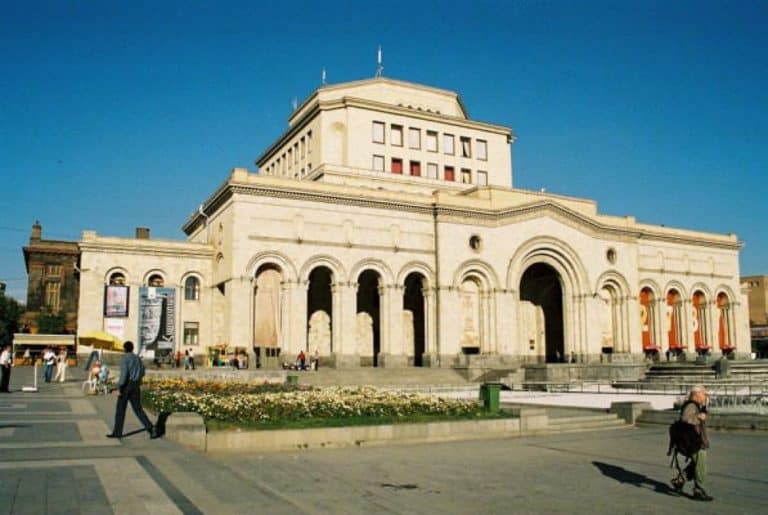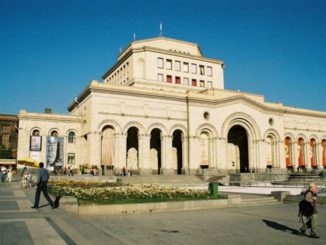Yerevan
Yerevan or Erevan as it is sometimes known, is the capital of Armenia and sits at around 1,000 metres above sea level on the banks of the River Hrazdan.
Erevan is located just a few kilometres from the Turkish border in the area of Mount Ararat.
Thanks to several archaeological digs which began in 1936 and continued until 2012 under the supervision of numerous different archaeologists, traces of the existence of local peoples dating back to 3,000 years BC have been uncovered.
However, it wasn’t until 782 BC when parts of the country were known as the kingdom of Urartu that King Argishtis commissioned the building of a military fortress to the west of the plateau of Ararat in order to be in a position to control trade between Europe and the Orient.
Right on the very ruins of the ancient fortress, situated in a strategic location where evidence of the country’s past history can still be found, the current capital of Armenia came into being.
Given the city’s situation with regard to control of commercial activities, Yerevan has always been seen as a target to be conquered and over the centuries, has been subjugated by a range of foreign invaders.
The territory was the subject of a dispute between the Persian Empire and the Ottoman Empire for many centuries and ended up being occupied by the Russian Empire in 1827.
In 1991, with the break-up of the Soviet Union, Yerevan became the capital of the Armenian Republic.
Since the country gained its independence, Erevan has enjoyed exponential growth in construction as well as both economically and culturally.
In fact, the city is now home to a variety of museums, libraries, universities, conservatoires, technical institutions and is also the home of the Matenadran Archives, a fabulous collection of extremely rare Armenian, Syrian, Greek, Hebrew, Persian and Roman manuscripts.
The city also boasts several theatres, botanical gardens and everything else one would expect to find in a modern and industrious new city.
Despite the numerous invasions and the devastation wreaked by a variety of earthquakes, some of the city’s most historic buildings have managed to survive into the present day in relatively good condition.
One of these is undoubtedly the church of Katoghike Tsiranavor which was built between 595 and 602 A.D. Sadly, the church was partially damaged in the earthquake of 1679 but is still recognised as the oldest church that can be visited in the Republic of Armenia.
The Zoravor Surp Astvatsatsin church is one of the best preserved in the city.
It was built in the Middle Ages and also partially collapsed as a result of the 1679 earthquake. However, it was restored in 1693-1694.
The cathedral of Saint Sarkis was also rebuilt between 1835 and 1842 and is the seat of the pontifical diocese of Ararat in the Armenian Church.
The Blue Mosque which is also called “Gok Jami “dates from 1764-1768 and is situated in the city centre.
It is the only functioning mosque in the state.
The Red Bridge over the River Hrazdan which was built in the 17th century was also damaged in the 1679 earthquake and was subsequently rebuilt in 1830.
There are various different ways to get around the city and this is managed by around 60 private companies which cover the city area with 120 different lines which may involve buses, minibuses or vans.
As of February 2017, 39 buses should have entered into service in order to provide additional transport around the city.
On some routes, you may opt for the subway which was inaugurated in 1981. It covers 13 kilometres and has 10 stops that are in use.
The style is “typically Russian,” with large chandeliers along the access tunnels and at the actual stops themselves – this is worth seeing!
Yerevan has only one railway station and this was also built in the Soviet style.
The capital is serviced by Zvartnots International Airport which is located around 12 kilometres from the city centre.
It was built during the Soviet period and was opened in 1961. It was refurbished for the first time in 1985 and then again in 2002 in order to comply with international regulations.
In 2006-2007 new terminals were built for both departures and arrivals. The work was unfinished but Yerevan’s airport came to be viewed as being the most modern in the Caucasus region.
However, to date, there is still no national airline.
Shopping on the last day
[ Autumn, 2005 ] We spent some time and money on the last day in Armenia. First, I bought two bottles of Armenian cognac. They were not the famous ‘Ararat’, but something else which was…


